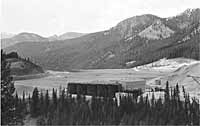Cyanide solution
Hecla Mining Co. prepares for multimillion dollar cleanup
"We’re spending a lot of time, money and energy to make sure
that the issue is resolved. Enough people are looking at this, believe me. It will be
safe."
Hecla spokeswoman Vicki Veltkamp
"Minimizing the environmental impact of Grouse Creek has been a
major consideration for us throughout the project construction and will continue to be a
major focus through the mine’s life and reclamation."
—Hecla Mining Co.’s chief executive, Art Brown,
according to an August 16, 1995 Hecla press release.
By GREG STAHL
Express Staff Writer
Hecla Mining Co.’s Grouse Creek gold mine was supposed to be a
state-of-the-art paragon of how large-scale, modern-day mining can be done in harmony with
the environment.
At the mine’s dedication on Aug. 12, 1995, in front of 450 Idahoans,
then-Rep. Mike Crapo applauded the mine’s developers for their care of the
area’s natural setting, according to a Hecla press release dated Aug. 16 of the same
year.
Hecla chief executive Art Brown called the mine an "environmentally
safe, efficient mine" during the celebration, the press release also stated.
That was then.
In response to leaks in the mine’s 500 million gallon tailings pond
that resulted in cyanide contamination of area streams, Hecla will be required to begin
draining the pond at the mine site in the Salmon River Mountains north of Stanley by May
1, 2001, Idaho’s Department of Environmental Quality (DEQ) and Forest Service
officials have announced.
 Hecla Mining Co. will have to begin draining its 500
million gallon tailings pond, pictured above, at the Grouse Creek Mine by May 1, 2001. Express
photo by Greg Stahl
Hecla Mining Co. will have to begin draining its 500
million gallon tailings pond, pictured above, at the Grouse Creek Mine by May 1, 2001. Express
photo by Greg Stahl
Presently the contamination is contained, and there is no threat to
wildlife or humans, DEQ, Forest Service and Hecla officials agreed.
On April 26 of 1999, Coeur d’ Alene-based Hecla reported high cyanide
levels in Jordan Creek, downstream from the now-closed gold mine, to the DEQ. Jordan Creek
is a tributary of the Yankee Fork, which flows into the Salmon River downstream from
Stanley.
Piquing environmentalists’ interest on the issue, the Yankee Fork and
Salmon River contain spawning habitat for endangered Chinook salmon and are also home to
endangered bull trout.
The pond’s toxic waters—containing cyanide used in the gold
extraction process as well as mercury, silver, copper, cadmium and other heavy
metals—will be treated using filtering and precipitation processes. They will then be
discharged into the Yankee Fork, according to DEQ regional administrator Jim Johnston.
Levels of permitted toxicity for discharged waters will be set by the DEQ
and Forest Service, but activists fear the permitted levels will be too high.
 Boulder
White Cloud Council mining activist Tom Blanchard explains his concerns associated with
the Grouse Creek Mine, north of Stanley, as he overlooks the mine’s open pit. Express
photo by Greg Stahl
Boulder
White Cloud Council mining activist Tom Blanchard explains his concerns associated with
the Grouse Creek Mine, north of Stanley, as he overlooks the mine’s open pit. Express
photo by Greg Stahl
"This mine was supposed to be state-of-the-art," Boulder White
Cloud Council mining activist Tom Blanchard said during a visit to the mine two weeks ago.
"I’d like to see a state-of-the-art solution."
Blanchard, who called the mine "the poster child for mining
reform," spoke as he surveyed the vast open pit and the tailings pond from high on
the side of neighboring Estes Mountain. Boats navigated the toxic pond’s waters, and
an aeration system, designed to accelerate the breakdown of cyanide, spouted water in the
thin mountain air.
The proposed treatment and discharge processes would treat pond water and
then dilute the discharge using the Yankee Fork in a so-called mixing zone—a
several-hundred-foot-long section of the river downstream from the discharge point.
Johnston said the specific levels that will have to be met are not yet
set.
"We’re in the process of trying to determine proper treatment to
ensure proper water quality issues and to ensure wildlife standards," Johnston said.
Hecla spokeswoman Vicki Veltkamp also offered reassuring words.
"We’re spending a lot of time, money and energy to make sure
that the issue is resolved," she said. "Enough people are looking at this,
believe me. It will be safe."
Blanchard isn’t satisfied with such answers.
"The alternative is to get it to [higher] water quality standards
before they get it into the stream," he said, calling the Yankee Fork and Salmon
River "an already tortured environment."
"How many times do we have to lose again and again?" Blanchard
asked. "We’re spending millions to clear the way for salmon to recover, but
we’re doing this kind of thing. We can make this water clean. It’s just a matter
of money."
Johnston said, however, that money is not an issue. He also said that
Hecla will be completely responsible for the "multimillion dollar" cleanup of
the pond.
Hecla spokeswoman Vetlkamp estimated that cleanup of the pond will run
Hecla roughly $30 million.
In studies carried out by Hecla and confirmed by a DEQ chemist, the
filtering and precipitation processes are best suited to draining the pond because of the
volume of water the system will need to move, Johnston said.
"We’re looking at discharging 800 to 900 gallons per minute in
order to exceed what’s going into the pond," Johnston said. "That
eliminated some of the things we were trying to look at."
Draining the pond, said Johnston, must adhere to the May 1, 2001 start
date, which is set in a consent agreement between DEQ and Hecla. Hecla vice president Bill
Booth signed the agreement on April 3, one day before DEQ state administrator Stephen
Allred did.
#
Shortly after reporting the contamination last spring, Hecla set up a
system of pumps and wells to recirculate cyanide-contaminated springs and seeps back into
the mine’s holding pond.
Since the pumps were turned on, cyanide levels in Jordan Creek "have
dissolved to almost [non-detectable levels]," said U.S. Forest Service Grouse Creek
coordinator Pat Trainor in an interview last week.
The mine is almost entirely positioned on Forest Service land, Trainor
said, and the federal agency will oversee the cyanide cleanup effort under the
Comprehensive Environmental Response Compensation Liability Act (CIRCLA).
CIRCLA, Trainor said, will help set water quality standards by which
treated water will ultimately be discharged into the Yankee Fork.
DEQ officials, Forest Service personnel and Hecla officials met for three
days last week to discuss how to proceed on the issue, Johnston said, adding that the
parties involved are still trying to iron out details surrounding the treatment and
discharge processes.
Veltkamp said Hecla, which has been in existence for 109 years, is
currently operating four mines in Nevada, Venezuela, Idaho and Alaska.
Hecla spent $100 million to build Grouse Creek, Veltkamp said, and has
lost, so far, $148 million in operations and cleanup efforts.
"The environment is still a large concern with us," she said,
"which is why we’re working so hard to clean it up."